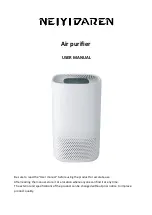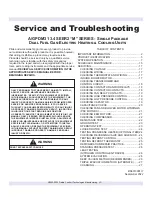
7 Configuration
Installer and user reference guide
32
RXYSCQ4~6TMV1B
VRV IV-S system air conditioner
4P404224-1C – 2019.07
7.2.9
To connect the PC configurator to the
outdoor unit
X41A
2
3
4
5
H J
ST
a
b
c (X41A)
A1P
a
PC
b
Cable (EKPCCAB)
c (X41A)
Extension cable connected to X41A
A1P
Outdoor unit main PCB
7.3
Energy saving and optimum
operation
This heat pump system is equipped with advanced energy saving
functionality. Depending on the priority, emphasises can be put on
energy saving or comfort level. Several parameters can be selected,
resulting in the optimal balance between energy consumption and
comfort for the particular application.
Several patterns are available and explained below. Modify the
parameters to the needs of your building and to realize the best
balance between energy consumption and comfort.
No matter which control is selected, variations on the behaviour of
the system are still possible due to protection controls to keep the
unit operating under reliable conditions. The intentional target,
however, is fixed and will be used to obtain the best balance
between energy consumption and comfort, depending on the
application type.
7.3.1
Available main operation methods
Basic
The refrigerant temperature is fixed independent from the situation. It
corresponds to the standard operation which is known and can be
expected from/under previous VRV systems.
To activate this in…
Change…
Cooling operation
[2‑8]=2
Heating operation
[2‑9]=2
Automatic
The refrigerant temperature is set depending on the outdoor ambient
conditions. As such adjusting the refrigerant temperature to match
the required load (which is also related to the outdoor ambient
conditions).
E.g., when your system is operating in cooling, you do not need as
much cooling under low outdoor ambient temperatures (e.g., 25°C)
as under high outdoor ambient temperatures (e.g., 35°C). Using this
idea, the system automatically starts increasing its refrigerant
temperature, automatically reducing the delivered capacity and
increasing the system's efficiency.
E.g., when your system is operating in heating, you do not need as
much heating under high outdoor ambient temperatures (e.g., 15°C)
as under low outdoor ambient temperatures (e.g., –5°C). Using this
idea, the system automatically starts decreasing its refrigerant
temperature, automatically reducing the delivered capacity and
increasing the system's efficiency.
To activate this in…
Change…
Cooling operation
[2‑8]=3 (default)
Heating operation
[2‑9]=1 (default)
Hi-sensible/economic (cooling/heating)
The refrigerant temperature is set higher/lower (cooling/heating)
compared to basic operation. The focus under high sensible mode is
comfort feeling for the customer.
The selection method of indoor units is important and has to be
considered as the available capacity is not the same as under basic
operation.
For details concerning to Hi-sensible applications, please contact
your dealer.
To activate this in…
Change…
Cooling operation
[2‑8] to the appropriate value,
matching the requirements of the
pre-designed system containing
a high sensible solution.
Heating operation
[2‑9] to the appropriate value,
matching the requirements of the
pre-designed system containing
a high sensible solution.
[2‑8]
T
e
target (°C)
4
8
5
9
6
10
7
11
[2‑9]
T
c
target (°C)
4
43
7.3.2
Available comfort settings
For each of above modes a comfort level can be selected. The
comfort level is related to the timing and the effort (energy
consumption) which is put in achieving a certain room temperature
by temporarily changing the refrigerant temperature to different
values in order to achieve requested conditions more quickly.
Powerful
Overshoot (during heating operation) or undershoot (during cooling
operation) is allowed compared to the requested refrigerant
temperature, in order to achieve the required room temperature very
fast. The overshoot is allowed from the start up moment.
▪ In case of cooling operation the evaporating temperature is
allowed to go down to 3°C on temporary base depending on the
situation.
▪ In case of heating operation the condense temperature is allowed
to go up to 49°C on temporary base depending on the situation.
▪ When the request from the indoor units becomes more moderate,
the system will eventually go to the steady state condition which is
defined by the operation method above.
To activate this in…
Change…
Cooling operation
[2‑41]=3.
This setting is used in
conjunction with setting [2‑8].
Heating operation
[2‑42]=3.
This setting is used in
conjunction with setting [2‑9]
















































